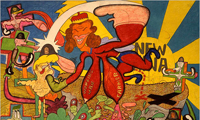 Out With the Fat, in With the Hungry
Out With the Fat, in With the Hungry By HOLLAND COTTER
Published: December 19, 2008
IN the past eight years American art and American politics had a lot in common. Both favored big money, insularity and retrograde conservatism. Now come changes.
In politics the old order was voted out. In the art world money is running out. Auctions are iffy. Galleries are closing. Museums are in slash-back mode. So 2009 could be 1989 all over again. Important to remember: The last crash opened the art world’s tightly guarded gates to a wave of upstart talent and radical new ways of thinking. That was great. It could happen again.
Meanwhile here are some notable events from 2008, a year that may go into the history books as the first catastrophic fall, but also the first vital correction, for art in the new century.
A MET LEADER Thomas Campbell was named the new director of the Metropolitan Museum of Art. He’s not well known, but what’s known is good: excellent curator, fine scholar, nice man. His job will be to firm up an institution that has come to rely too heavily on the lulling allure of imported luxe. He will want to find ways to make the museum’s permanent collection galleries look like special exhibitions: smart, fabulous, constantly changing shows, spiced with maybe a few sexy loans. The Met’s Chinese galleries have set a sterling model. If he will trust in the imagination of his curators, and let them go nuts once in a while, he’ll do fine.
LOS ANGELES MUSEUMS, PLUGGED IN AND ALMOST UNPLUGGED Michael Govan, at the Los Angeles County Museum of Art, has trusted imagination, and that paid off. The new Broad collection display is a boilerplate bore, and the museum still looks all over the place. But this year it also felt wired into the city around it, with a feisty show of young Chicano artists, a (tiny) first-time African display and reinstalled pre-Columbian galleries. Jorge Pardo’s design for those galleries has problems, but it got people talking and looking. People were also talking about the Los Angeles Museum of Contemporary Art, because it may disappear. It’s a funny place, with its internationalist sheen and market-driven program occasionally interrupted by inspired, could-only-happen-here shows. The city needs a contemporary museum, no question. But is this the right one?
CHINA’S EXPERIMENT When Chinese contemporary art went international a decade ago, it had a manic energy and few rules. Today the gallery scene in Beijing is all but identical to that in New York: same spaces, same hype, same percentage of bad product. Far more interesting are new finds of old art — bronzes, ceramics, sculptures, entire cultures — coming out of Chinese soil. Provincial museums are experimenting with fresh ways to exhibit the material effectively, the biggest challenge being how, or whether, to make discoveries like tomb murals, too fragile to be moved, accessible.
INDIA BOILS Indian contemporary art went at record auction prices, even as its best-selling artist, M. F. Husain, remained in exile. Mr. Husain, 93, left India for Dubai two years ago to avoid lawsuits and personal threats from religious nationalists who accused him, a Muslim, of painting blasphemous nude images of Hindu goddesses. In May an Indian court dismissed obscenity charges, though the situation remains volatile. Coincidentally three paintings by Mr. Husain that hung in the lobby of the Taj Mahal hotel in Mumbai were destroyed in last month’s terrorist siege.
REASCENDANT PAINTERS Judiciously scaled exhibitions of two artists too rarely seen in the United States were season highlights: “Poussin and Nature” at the Met, and the Peter Saul retrospective at the Orange County Museum of Art in California. Poussin turned Classicism into Romanticism, and gave Gustave Courbet — the subject of his own T. rex of a Met survey — a target to shoot at. Mr. Saul, our most scathing and elusive history painter, tackles global politics and personal weirdness with the same awful relish. He might well have invented Rod R. Blagojevich.
PHOTOGRAPHIC MAGIC William Eggleston took us on an acid-trip tour of the Deep South in his Whitney retrospective. The curator Okwui Enwezor offered a morgue-cold view of the modern world in “Archive Fever” at the International Center of Photography. Both cast an unshakable spell.
FEMINISM LIVES Strong exhibitions of work largely from the 1970s by Judith Bernstein, Lorraine O’Grady, Barbara T. Smith and Martha Wilson demonstrated that art emerging from early feminism was and is The Source. A HOLE IN THE FLOOR For his show titled “You” at Gavin Brown’s Enterprise, Urs Fischer destroyed the gallery floor with jackhammers, then excavated the earth beneath. Gallery visitors climbed down into an open pit. Footing was uncertain and sharp rocks poked up. Who knew what pollutants lurked? This was art after the bottom fell out.
ADIEU TO AN ALTERNATIVE Triple Candie, Manhattan’s one truly alternative alternative space, closed. Located in Harlem, it began with solid, traditional shows. By the end it was showing anonymous work by real artists and signed work by fictional artists. In the process it exploded the meanings of creativity, history, authenticity and value. And it gave lessons in advance on how art and artists can survive, even thrive, in hard times, which of course they will.
 Out With the Fat, in With the Hungry
Out With the Fat, in With the Hungry